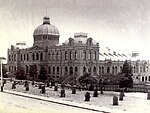Adelaide Botanic High School
2019 establishments in AustraliaAdelaide Park LandsEducational institutions established in 2019Public schools in South AustraliaSecondary schools in Adelaide ... and 2 more
Special interest high schools in South AustraliaUse Australian English from June 2019
Adelaide Botanic High School is a coeducational public secondary school situated on Frome Road in Adelaide, South Australia. The school's campus is situated on land adjoining the Adelaide Botanic Garden and the former site of the Royal Adelaide Hospital and is partly built from the structure of the old Reid Building from the University of South Australia.
Excerpt from the Wikipedia article Adelaide Botanic High School (License: CC BY-SA 3.0, Authors).Adelaide Botanic High School
Frome Road, Adelaide Adelaide
Geographical coordinates (GPS) Address External links Nearby Places Show on map
Geographical coordinates (GPS)
| Latitude | Longitude |
|---|---|
| N -34.917 ° | E 138.607 ° |
Address
Adelaide Botanic High School
Frome Road
5000 Adelaide, Adelaide
South Australia, Australia
Open on Google Maps







